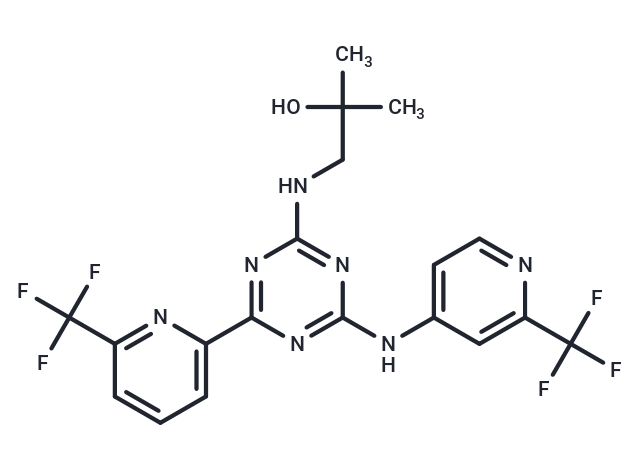Shopping Cart
Remove All Your shopping cart is currently empty
Your shopping cart is currently empty
Enasidenib (AG-221) is an orally available inhibitor of specific mutant forms of the mitochondrial enzyme isocitrate dehydrogenase type 2 (IDH2), with potential antineoplastic activity.

| Pack Size | Price | USA Warehouse | Global Warehouse | Quantity |
|---|---|---|---|---|
| 5 mg | $39 | In Stock | In Stock | |
| 10 mg | $64 | In Stock | In Stock | |
| 25 mg | $94 | In Stock | In Stock | |
| 50 mg | $113 | In Stock | In Stock | |
| 100 mg | $147 | In Stock | In Stock | |
| 200 mg | $218 | In Stock | In Stock | |
| 500 mg | $369 | - | In Stock | |
| 1 mL x 10 mM (in DMSO) | $43 | In Stock | In Stock |
| Description | Enasidenib (AG-221) is an orally available inhibitor of specific mutant forms of the mitochondrial enzyme isocitrate dehydrogenase type 2 (IDH2), with potential antineoplastic activity. |
| Targets&IC50 | IDH2 (R172K):400 nM, IDH2 (R140Q):100nM |
| In vitro | The compound has been demonstrated to reduce 2-HG levels by >90% and reverse histone and deoxyribonucleic acid (DNA) hypermethylation in vitro, and to induce differentiation in leukemia cell models[2]. |
| In vivo | Enasidenib is able to potently reduce 2HG found in the bone marrow, plasma and urine of engrafted mice. Treatment also induced a dose dependent, statistically significant, survival benefit. A proliferative burst of the human specific CD45+ blast cells is followed by cellular differentiation as measured by the expression of CD11b, CD14 and CD15 and cell morphology after Enasidenib treatment[2]. Enasidenib treatment also restores megakaryocyte-erythroid progenitor (MEP) differentiation that is suppressed by mutant IDH2 expression and reverses the effects of mutant IDH2 on DNA methylation in mutant stem/progenitor cells. Clinicalal trials combining IDH2 inhibitors with other targeted AML therapies are warranted in order to increase therapeutic efficacy[1]. |
| Kinase Assay | Untranslated region-mediated luciferase reporter expression: HEK293 cells are transfected with a GEMS reporter vector that contains the luciferase open-reading frame flanked by and under post-transcriptional control of the BMI-1 5′ and 3′ UTRs. The resulting stable cells (F8) are treated with PTC-209 or vehicle control overnight, and then luciferase reporter activity is determined using Bright-Glo assays. The assays are run in triplicate for each point, and the percentage of inhibition was calculated against vehicle control. |
| Synonyms | AG-221 |
| Molecular Weight | 473.38 |
| Formula | C19H17F6N7O |
| Cas No. | 1446502-11-9 |
| Smiles | CC(C)(O)CNc1nc(Nc2ccnc(c2)C(F)(F)F)nc(n1)-c1cccc(n1)C(F)(F)F |
| Relative Density. | 1.477 g/cm3 (Predicted) |
| Color | White |
| Appearance | Solid |
| Storage | store at low temperature,keep away from moisture | Powder: -20°C for 3 years | In solvent: -80°C for 1 year | Shipping with blue ice/Shipping at ambient temperature. | |||||||||||||||||||||||||||||||||||
| Solubility Information | H2O: < 1 mg/mL (insoluble or slightly soluble) Ethanol: 100 mg/mL (211.25 mM), Sonication is recommended. DMSO: 245 mg/mL (517.55 mM), Sonication is recommended. | |||||||||||||||||||||||||||||||||||
| In Vivo Formulation | 10% DMSO+40% PEG300+5% Tween 80+45% Saline: 5 mg/mL (10.56 mM), Sonication is recommended. Please add the solvents sequentially, clarifying the solution as much as possible before adding the next one. Dissolve by heating and/or sonication if necessary. Working solution is recommended to be prepared and used immediately. The formulation provided above is for reference purposes only. In vivo formulations may vary and should be modified based on specific experimental conditions. | |||||||||||||||||||||||||||||||||||
Solution Preparation Table | ||||||||||||||||||||||||||||||||||||
Ethanol/DMSO
| ||||||||||||||||||||||||||||||||||||
| Size | Quantity | Unit Price | Amount | Operation |
|---|

Copyright © 2015-2025 TargetMol Chemicals Inc. All Rights Reserved.